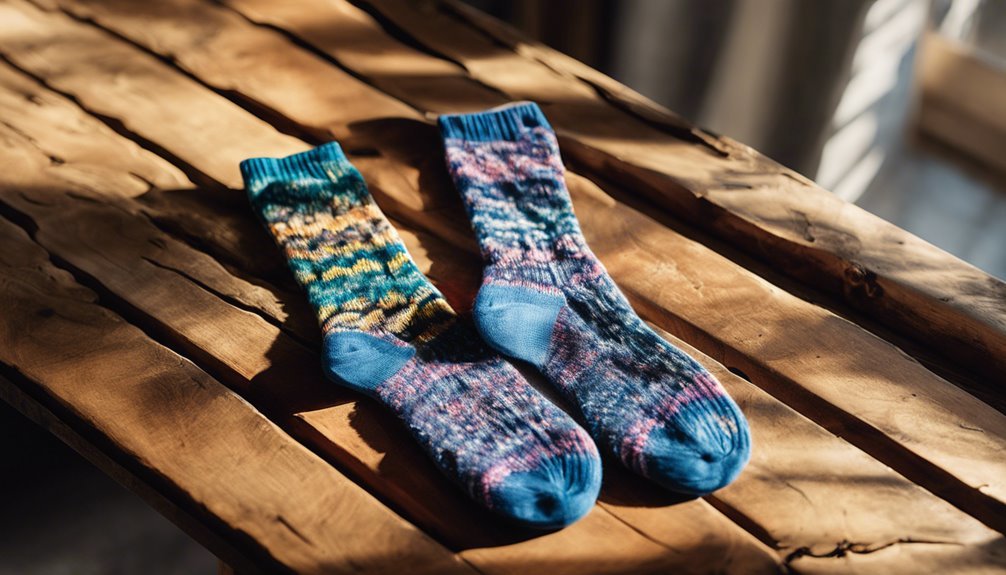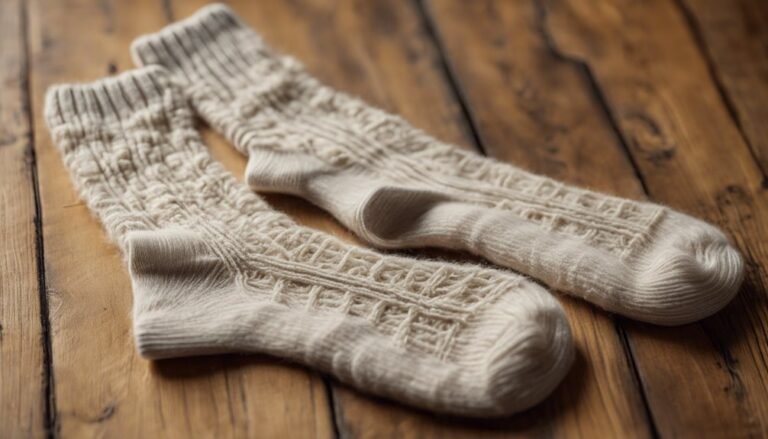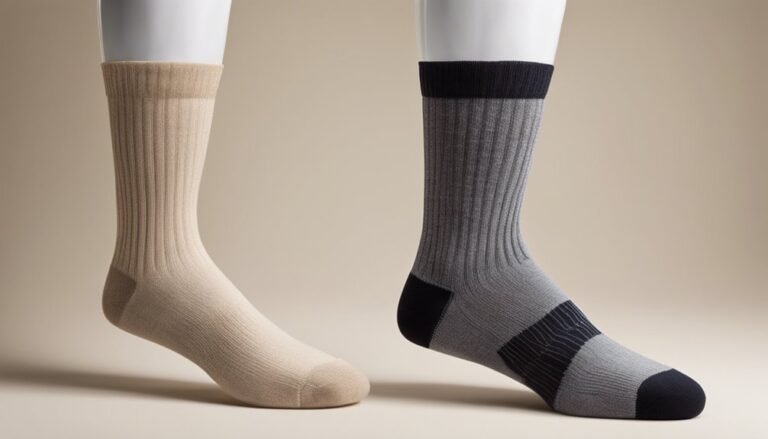Made-in-USA Socks vs. Imported Socks: Does Quality Differ?
When comparing made-in-USA socks to imported options, quality often varies greatly. U.S. manufacturing emphasizes higher fiber quality, ethical labor practices, and rigorous quality control, which leads to better durability and comfort. In contrast, imported socks might use lower-grade materials, compromising their longevity and fit. While made-in-USA socks tend to have a higher price tag, value is found in their long-lasting performance. There's much more to explore about these differences that could impact your sock choices.
Understanding the Manufacturing Process of Socks

When you explore the manufacturing process of socks, you'll find that it involves several critical steps, each influencing the final product's quality and characteristics. Sock production begins with yarn selection, where different fibers can affect comfort and durability. Next, manufacturing techniques such as knitting and stitching come into play, shaping the sock and ensuring it fits properly. The quality control phase is essential, as it identifies defects that could compromise performance. Finally, finishing touches like washing and packaging are completed before distribution. Each step in this process not only determines the functionality of the socks but also reflects the brand's commitment to quality. By understanding these elements, consumers can make informed choices about their sock purchases.
Materials Used in Made-in-USA Socks vs. Imported Socks
When comparing Made-in-USA socks to imported options, you'll notice significant differences in fiber quality and sourcing practices. Many American manufacturers prioritize sustainable materials, which can impact both durability and environmental footprint. Understanding these factors can help you make a more informed choice about the socks you wear.
Fiber Quality Comparison
A key factor in the quality of socks is the materials used, and this aspect often differentiates Made-in-USA socks from their imported counterparts. When you consider fiber durability, many domestic manufacturers source high-quality yarns that can withstand wear and tear, ensuring longer-lasting products. In contrast, some imported socks may utilize lower-grade materials, which can compromise their longevity. The yarn source plays a significant role here; U.S. manufacturers often prioritize local sheep's wool or advanced synthetic fibers, which are engineered for enhanced performance. Imported options may rely on cheaper, mass-produced fibers that don't hold up as well over time. Ultimately, the choice of materials directly impacts both the comfort and durability of the socks you wear daily.
Sourcing and Sustainability Practices
Sourcing and sustainability practices greatly influence the overall impact of sock production, particularly when comparing Made-in-USA socks to imported ones. When you choose Made-in-USA socks, you're often supporting brands that prioritize ethical sourcing and eco-friendly materials. These socks frequently utilize organic cotton, recycled fibers, or sustainable merino wool, minimizing their environmental footprint. In contrast, many imported socks may rely on cheaper materials and production methods that compromise ethical standards. This can lead to issues like poor labor practices and unsustainable resource use. By understanding these differences, you can make informed choices that align with your values, ensuring that your sock purchases contribute positively to both the environment and the economy.
Evaluating Durability: How Long Do They Last?
How can you determine the durability of socks, whether they're made in the USA or imported? You'll want to evaluate several longevity factors, including materials, construction quality, and intended use. Consumer experiences often reveal that socks made from high-quality fibers like merino wool or reinforced blends tend to last longer. Additionally, pay attention to features like reinforced heels and toes, which can enhance durability. Importantly, the manufacturing process can impact longevity; socks made in the USA often adhere to stricter quality standards, while imported options may vary. Ultimately, your choice should align with your lifestyle and how frequently you wear them, as these factors directly influence how long you can expect them to last.
Comfort Levels: Fit and Feel of Different Socks
When you consider comfort levels in socks, material composition plays an essential role in how they feel against your skin. The design and construction quality can greatly affect both fit and overall comfort, while sizing and fit variability can lead to different experiences even within the same category. Understanding these factors can help you choose the right socks for your needs.
Material Composition Impact
The choice of materials used in socks greatly influences their comfort levels, fit, and overall feel. When you consider material sourcing, you'll find that natural fibers like cotton and merino wool often provide superior breathability and moisture-wicking properties compared to synthetic alternatives. These materials enhance textile performance, ensuring your feet remain dry and comfortable throughout the day. Additionally, the blend of materials can impact elasticity and durability, essential for a snug fit that doesn't compromise comfort. Imported socks may use cheaper materials, which can lead to less efficient performance. Ultimately, understanding how different materials affect sock comfort can empower you to make informed choices, ensuring your feet enjoy the freedom they deserve.
Design and Construction Quality
While many factors contribute to the overall comfort of socks, design and construction quality play an essential role in determining fit and feel. The use of advanced stitch techniques can enhance durability and reduce irritation, allowing for a more enjoyable wearing experience. Made-in-USA socks often benefit from meticulous craftsmanship, ensuring that seams and patterns align precisely, which can improve overall comfort. In contrast, some imported socks may rely on cost-cutting measures that sacrifice these fundamental elements. Additionally, design innovations, such as targeted cushioning and arch support, can greatly affect how socks conform to your feet. Ultimately, understanding these aspects helps you make an informed choice about which socks will provide the comfort and performance you desire.
Sizing and Fit Variability
Fit and feel are greatly influenced by sizing and variability, which can differ widely between made-in-USA and imported socks. Understanding these differences is essential for ensuring comfort, especially when considering your fit preferences.
- Size Charts: Made-in-USA socks often adhere to more standardized size charts, while imported options may vary in sizing, leading to inconsistencies.
- Materials: Different materials can affect stretch and recovery, impacting how the sock fits over time.
- Design Features: Features like arch support and cushioning can vary, playing a significant role in how snugly a sock hugs your foot.
Sustainability Practices in Domestic vs. Imported Production

When comparing sustainability practices in domestic and imported sock production, it's important to take into account factors like resource use, waste management, and labor conditions. Domestic production often emphasizes ethical sourcing, prioritizing local materials and reducing transportation emissions. This can lead to a lower overall environmental impact. In contrast, imported socks may involve longer supply chains, which can increase carbon footprints and complicate waste management practices. However, some foreign manufacturers are adopting sustainable practices, like recycling and eco-friendly materials. Ultimately, your choice might hinge on the specific brands and their commitment to sustainability. By supporting companies dedicated to responsible production, you can align your purchases with your values regarding environmental stewardship and ethical sourcing.
The Impact of Labor Standards on Sock Quality
As labor standards directly influence the quality of sock production, it's crucial to examine how these regulations vary between domestic and imported manufacturing. Strong labor regulations often lead to better working conditions, which can enhance the craftsmanship and materials used in sock production. When you consider ethical sourcing, the implications become even clearer:
- Worker Treatment: Higher standards often guarantee fair wages and safe environments.
- Material Selection: Ethical sourcing can lead to the use of higher-quality materials, impacting durability.
- Manufacturing Process: Rigorous labor standards can improve overall production practices, yielding superior products.
In contrast, imported socks may prioritize cost over quality, resulting in compromised standards. Understanding these differences can help you make informed choices about the socks you buy.
Price Comparison: What Are You Really Paying For?
What factors influence the price of socks, and how do they compare between made-in-USA and imported options? When you consider price perception, it often hinges on where the socks are produced. Made-in-USA socks generally command higher prices due to labor costs, quality materials, and adherence to strict regulations. On the other hand, imported socks might appear cheaper but can involve compromises in quality or sustainability. Your value assessment should focus on durability, ethical production, and long-term costs versus initial savings. While you might pay less upfront for imported socks, consider whether they'll last as long as their American-made counterparts. Ultimately, you're not just paying for the product; you're investing in the principles and quality behind it.
Frequently Asked Questions
Are Made-In-Usa Socks More Expensive Than Imported Ones?
When you consider price comparison, made-in-USA socks often carry higher costs due to quality assurance and labor standards. However, you might find that the investment reflects durability and comfort, potentially justifying the expense.
Do Imported Socks Have a Shorter Lifespan Than Domestic Socks?
When you slip on a pair of socks, consider their durability. Imported socks may use varying manufacturing materials, sometimes leading to shorter lifespans. Quality often hinges on the materials and craftsmanship, not just origin.
Are There Specific Brands Known for High-Quality Imported Socks?
When considering brand comparisons, several imported sock brands excel in quality assessments. Brands like Smartwool and Darn Tough are often praised for their durability and comfort, proving that imported options can meet high standards effectively.
How Does Consumer Preference Affect Sock Manufacturing Locations?
"You get what you pay for" rings true as consumer trends increasingly emphasize manufacturing ethics. Preferences for ethically produced goods can shift manufacturing locations, encouraging brands to adapt and meet demand for quality and responsibility.
Can Imported Socks Still Be Ethically Produced?
Yes, imported socks can be ethically produced if manufacturers prioritize ethical sourcing and uphold fair labor practices. Consumers should research brands to guarantee they support companies committed to transparency and responsible production, promoting global ethical standards.







